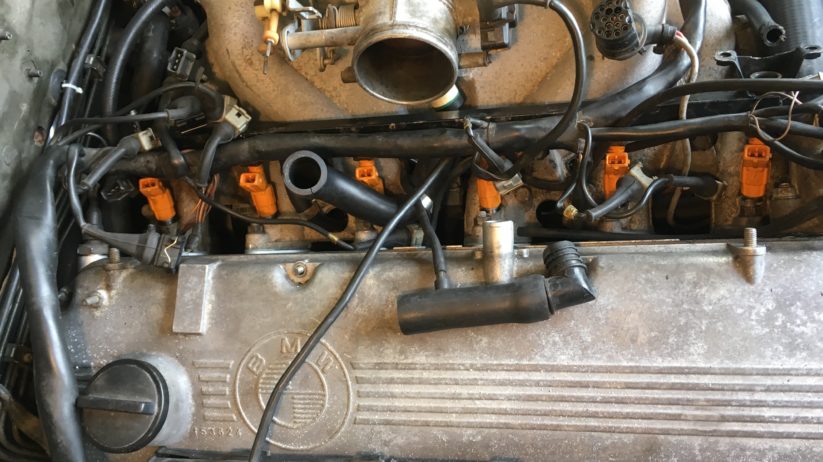Last week I made the surprise announcement that, to ease my cash flow and simplify my life a bit, I sold the Lama, my recent E28 5 Series acquisition. The buyers are Jim and Susan Brown Strickland. Well, Jim is technically the buyer; Susan is along for the ride to entertain the Hack Mechanic faithful and torment yours truly (see below).
When Jim met my $4,250 asking price, I said that I’d do three additional repairs: replace the injectors, install an antenna and find out what the status is of the a/c system, which Mister I Wrote An Air-Conditioning Book hadn’t even turned on.
Let’s start with the injectors. Last year, after I’d resurrected the Black Shark (the dead ’85 635CSi that I got for free from my son’s girlfriend’s father), it ran quite poorly. After talking with E28 guru Paul Muskopf, it seemed likely that the injectors were at fault. You can try to diagnose them in place by testing their resistance (which is basically checking for a break in the wire winding the solenoid inside), or by connecting a fuel-pressure gauge and pulsing each one with a tool like this and seeing if they all bleed down the fuel pressure at the same rate. You can also remove the injectors and clean them yourself, or send them off to be cleaned and tested.
Now, those of us who work on our own cars make all sorts of choices regarding where the water’s edge is for what we’re willing to pay someone else to do. One example is that for a number of reasons, I rarely rebuild brake hydraulics or electrical components; I’m content to pay the money for a new or rebuilt starter or alternator or caliper, wait for it to arrive, then go to the garage, yank the old one out, install the new one, and pat myself on the back for having saved on the repair by doing all of the labor myself. I don’t always need to get the last 15% by also rebuilding the part myself.
I’m this way with injectors. Even if I cleaned them myself, I don’t really have a way to verify that the spray patterns are good. On Black Shark, I bought a set of remanufactured Bosch 4-nozzle injectors for $80 on eBay. They worked well, so I recommended to Jim that he do the same. (The Lama wasn’t running anywhere near as horribly as the Black Shark had been, but because the car had sat for five years, and because the idle was a bit rough and there was the slightest bit of even-throttle hesitation, I thought it could benefit from fresh injectors). Jim ordered them and had them shipped to my house.
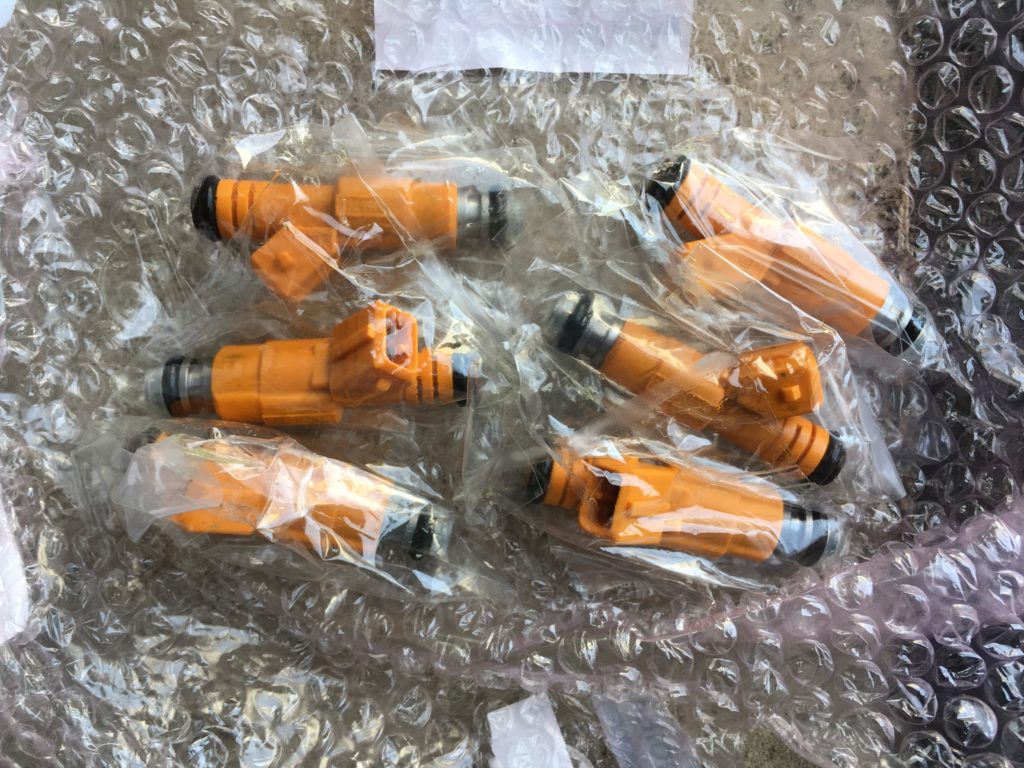
The $80 four-nozzle injectors looked so clean and pretty when they arrived.
Replacing the injectors on a 1980s-era BMW is very straightforward. They sit squeezed between the fuel rail and the intake manifold, with rubber O-rings at the top and bottom. It’s really just a matter of removing each injector’s clip and electrical connector, unbolting the fuel rail from the manifold and pulling it away from the injectors, and working the injectors free.
To get the fuel rail out, you need to remove stuff that’s in the way, which includes the intake bellows, air flow meter, idle air control valve, and the front and rear braces. Even if the rubber seals on the injectors are hardened, the injectors should pull out fairly easily; the seals aren’t a snap-in fit or anything. Be aware that a fair amount of fuel is going to pourout of the fuel rail when you pull it off the injectors, so prepare to catch it in a drip pan when it does. Then use a Q-Tip and brake cleaner to clean out the ports the injectors sit in in the intake manifold.
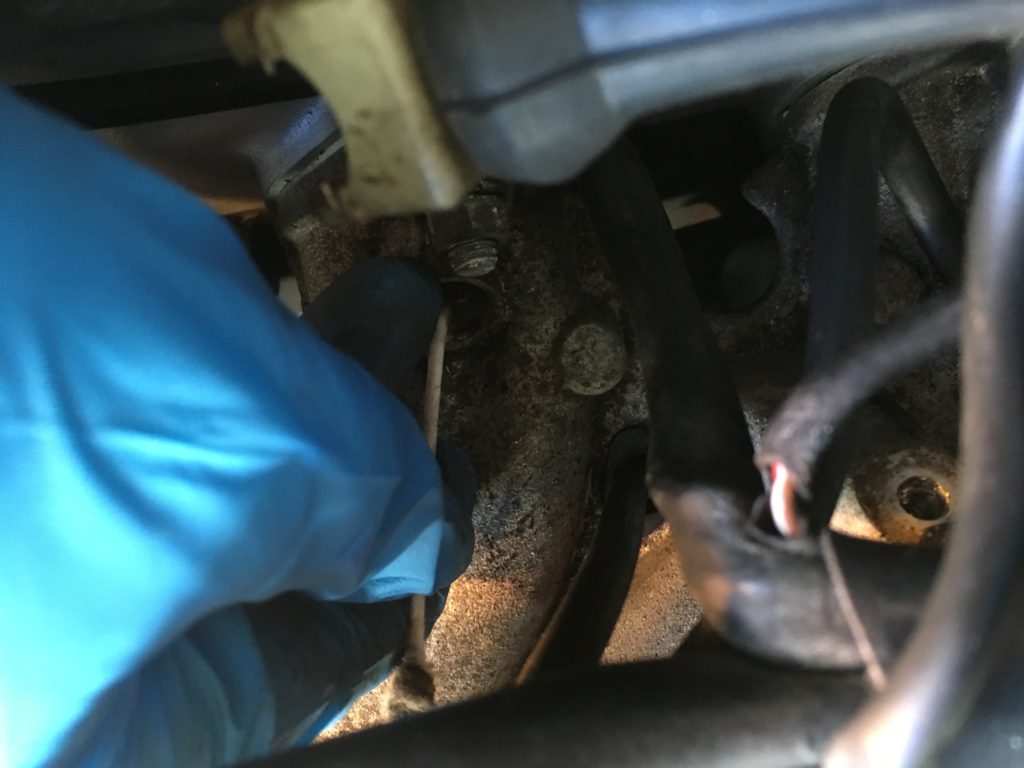
Many Q-tips were sacrificed in service of cleaning the Lama’s injection ports.
You can, in theory, leave the fuel rail with the gas lines on it, pull out the injectors, pop new ones in place, and clamp the fuel rail over them, but I don’t recommend it. It’s really best to detach the gas lines from the rail and remove it completely from the car by snaking it through the wiring harness. That allows you to turn it upside down and thoroughly clean the insides of the cups where the O-rings need to seat. I wound up needing to scrape quite a bit of corrosion and varnish off the cups on the Lama’s fuel rail. I then used brake cleaner and compressed air to blow the inside of the fuel rail out, and the amount of sediment and flaking paint that came out made me glad I did.
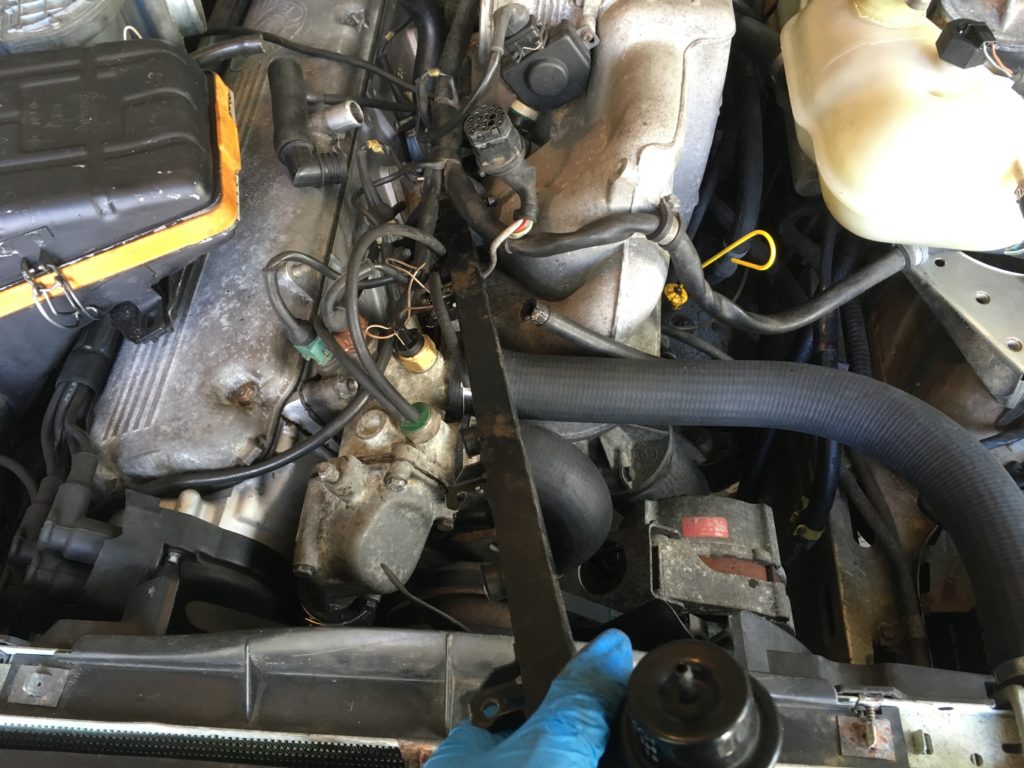
Tip the fuel rail to get it out from under the wiring harness.
Although very few M30 engines have a true sewing-machine idle, with the new injectors in the Lama, the idle is certainly smoother than it had been. Owing to the copious quantities of salt still on the roads, I haven’t driven the car yet.
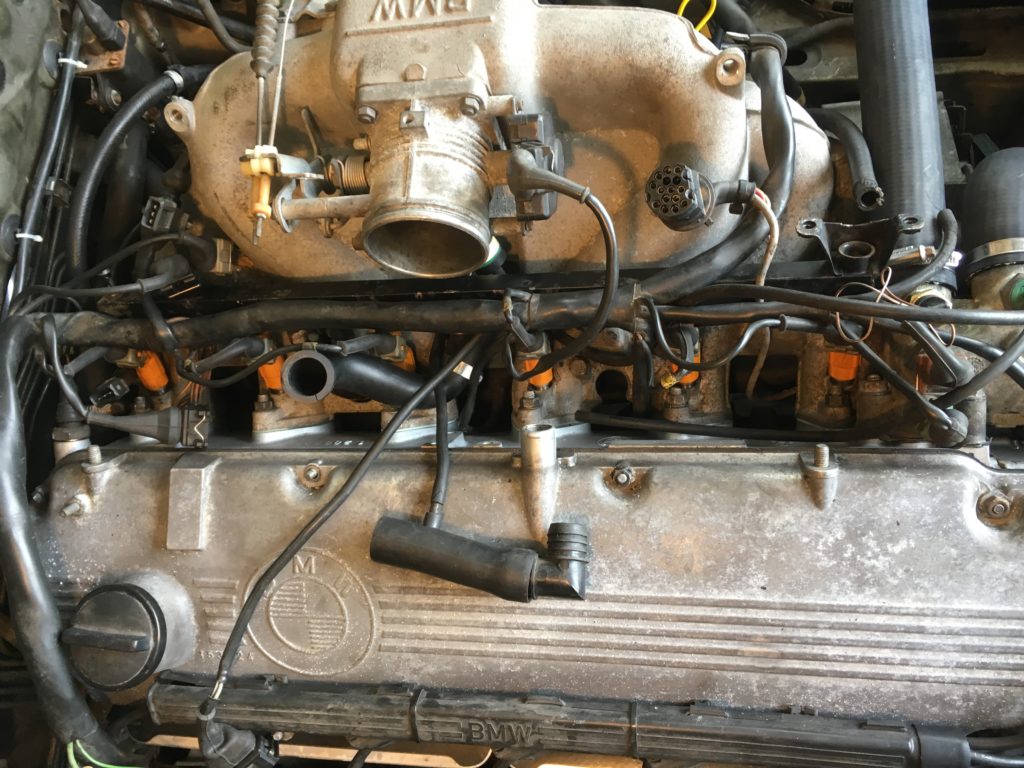
Damn, that was satisfying!
Next on the list was the antenna. When the Lama arrived at my house in September, the mast of the Hirschmann power antenna had been broken in transit. I possibly could’ve filed a claim against the shipper, but when I discovered the broken rocker arm, the antenna seemed like a drop in the bucket. Upon researching it, I found that inexpensive replacements masts are readily available, but mine appeared to have also broken a not-easily-orderable piece that the mast slid into, and was also missing the long-NLA metal grommet that sits on top.
I found that a Hirschmann 781 manual antenna is readily available for about $35 on eBay, and comes with all the needed mounting hardware. I sent Jim the link, he ordered the part, and I had it installed in about five minutes. I wish that everything in automotive repair were this easy.
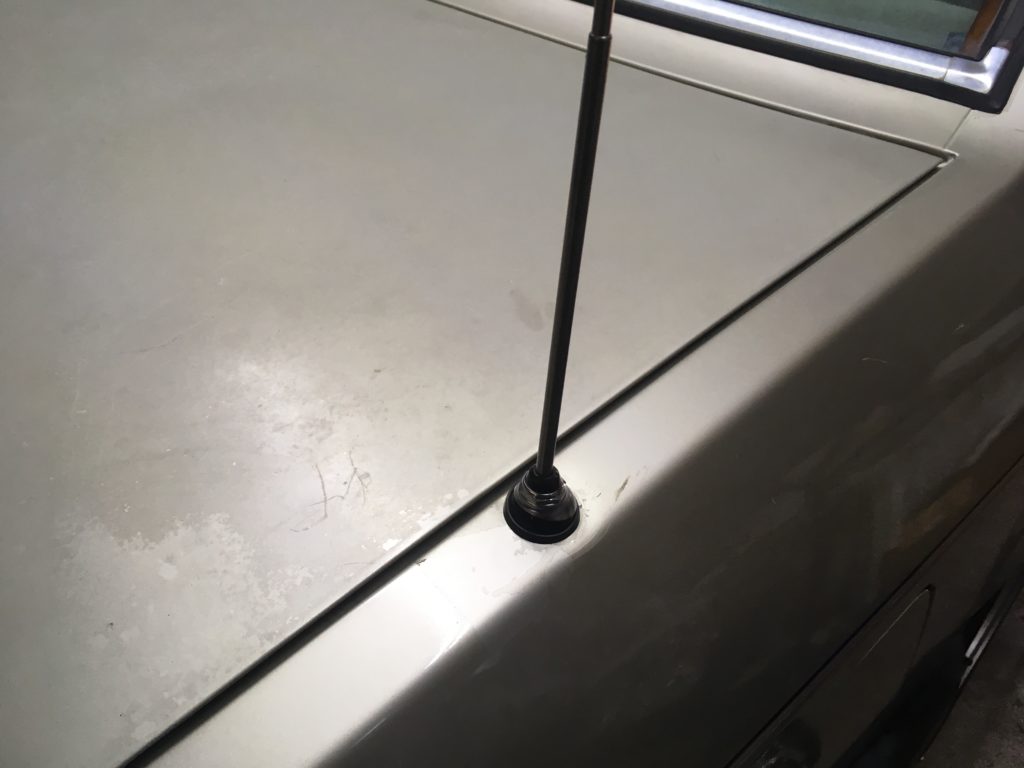
The $35 Hirschmann 781 manual antenna neatly plugged the hole that had been empty for months.
Last was the air-conditioning. Having only gotten the Lama running and driving in November, I literally hadn’t even turned the a/c on. During a 50-degree day last week, I verified that the compressor wasn’t seized—that is, when I turned on the a/c, I could see the compressor pulley turning—but it didn’t feel like the system was generating any cold air. I connected a manifold-gauge set, and found that there was no pressure, indicating that all of the refrigerant had leaked out of the system.
As I describe in my air-conditioning book, the next step is to see how bad the leak is, and perhaps where it’s coming from. I connected my nitrogen bottle to the center hose of the gauge set and pressurized the system. When you do that, one of three things happens:
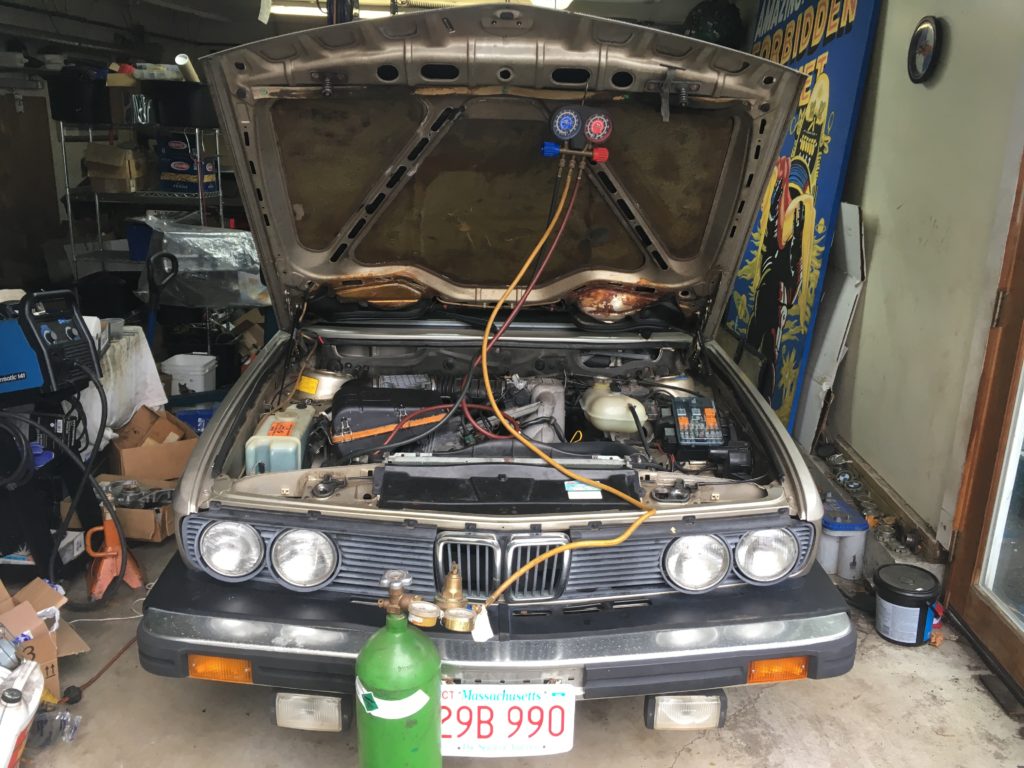
This shows the manifold gauge set and nitrogen bottle connected to the Lama’s a/c system.
First, the pressure can instantly escape if a component is catastrophically damaged, such as a punctured condenser or a blown-off hose. When this happens, the sound of the escaping nitrogen usually leads you to straight to the problem.
The second possibility is that the system may have a leak that’s small enough that the gauges show it holding pressure, but big enough that the nitrogen escapes over the course of minutes. If that happens, using a leak-detecting soap solution should easily and quickly reveal the source of the leak, provided you can spray it where the system is leaking.
The third possibility is that the system holds pressure over the course of minutes, but reveals a pressure drop when left for hours. When this happens, it means that the leak is smaller and is therefore going to be tougher to detect. Leak-detecting soap solution needs to be sprayed on every a/c hose and component, and after waiting for several hours, the tell-tale “cocoon” of small bubbles can be searched for.
I pressurized the Lama up to about 130 psi (slightly past the highest reading on the blue low-pressure gauge), shut off the nitrogen, closed the valves on the gauges, and watched for several minutes. The readings sat steady. So whatever leak the system has isn’t a glaring one.

Pressure-testing to about 130 psi.
But when I came down to the garage the following morning, I saw something I’ve never seen before: The low-pressure gauge is sitting exactly where I left it, but the high-pressure gauge has dropped to zero.
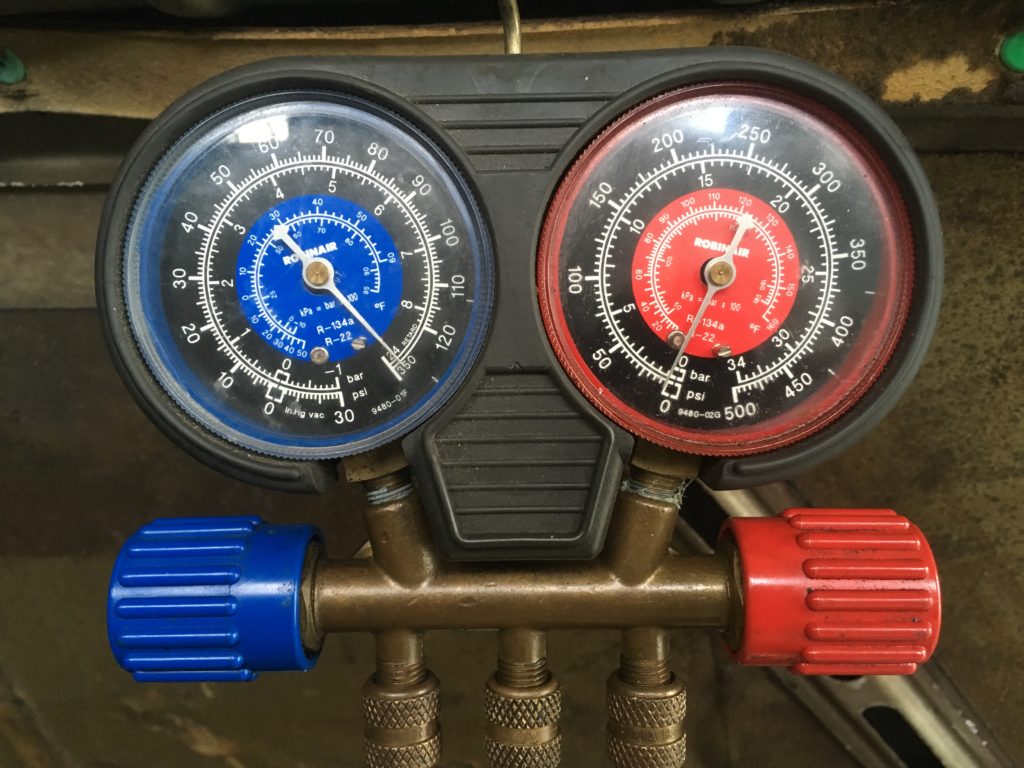
A surprising set of readings.
This means two things: One is that there’s a leak on the high-pressure side of the system (which includes the discharge side of the compressor, the condenser, the receiver-dryer, and the expansion valve inlet). The other is that, since the pressure normally equalizes between the low and high portions of the system because the expansion valve is normally open, it’s likely that the expansion valve is clogged or stuck shut.
I had to report to Jim that, if I were resurrecting the car’s a/c, I’d first try and find the leak, then pull the evaporator core and expansion valve, flush the core, flush the condenser and every hose, replace the expansion valve, and install a new receiver-drier (as you do whenever a system has been opened). Since you’re going to all that effort, it would be wise to remove the compressor, turn it upside down to drain it of old oil (which is the only way to know how much oil it has in it; they don’t have dipsticks), fill it with fresh oil, reassemble, pressure-test, evacuate, and recharge. Whether I do this work for Jim prior to delivery is under discussion.
That’s the nuts-and-bolts stuff. Onto the fun stuff.
In last week’s piece, I mentioned that I’d previously swapped some fun e-mails with Jim’s wife, Susan Brown Strickland, when she ordered a book for Jim last summer. In part of the back-and-forth, I learned that she owned a Triumph Stag. I mentioned this in last week’s piece (what I said was “Instant cred there, right?”). Well, Susan had something to say about that. The following smack-down—that’s her smacking, and me down—occurred a few days ago on Facebook.
Susan: “Based on the introduction of the Susan character into your article, there are two possible outcomes in how this could go down. In the first scenario, the ‘instant credibility’ assigned to me based on my first love (’71 Triumph Stag) could be sincere in the knowledge that there is no BMW body style remotely sexier in that era.”
Me: “I await the second with bated breath. Just please no sudden reveals that you own a pink Pacer or anything.”
Whoooo boy, did I poke a hornet’s nest.
Susan: “The second scenario paints a delightfully deceptive picture of competence crushed in condescension and praise veiled in pity as you bestow upon the Susan character tongue-in-cheek ‘instant credibility’ paired with a benevolent pat on the back and a wink over the head to your disciples of superior German engineering. You scoff at my pure, unadulterated love of form over function, passion above power, heart palpitations versus horsepower. In my best Monty Python screech, Neh, I say, neh. To be fair, I too was initially lured by his mastery of aesthetics. He was hard without thrusting his sensuality at me and his glove-soft leather drivers seat provided a panel of gleaming chrome instruments buried deep within the rich recesses of burnished burl, and most importantly, an unlit check-engine light. It was surely a sign to me from the Car Gods that my split apart had found me. Not to be lumped into the category of naive predecessors (the vapid, shallow-minded, tongue-lolling, panty-(and wallet)-throwing girls who came before me), I wanted more so I dared to look under his hood and body. There before me was a Buick 300, T-350…”
Susan: “I had to stop because Jim said you were innocent of all malicious intent at impugning my integrity… and I’m at the grocery store!”
Me: “Well, I was… UNTIL NOW!”
Susan: “Oh, IT IS ON!”
Scott Aaron: “You have to be careful when you become a character in one of Rob’s writing things….”
Susan: “Scott, he is the one who should be careful…. I write murder mysteries. He posted my written tongue-lashing to garner support from his disciples in lieu of a simple admission of guilt followed by a heartfelt apology.”
Me: “I am in such deep doo-doo. You know how I’ve said that one of the things I love about writing about these cars is that I have the power to change the ending to a story? Like with Brian Ach’s car, where at first I couldn’t fix it, but then I did? She’s got me beat. SHE COULD KILL ME!”
Susan: “Rob, only small minds resort to violence and/or homicide. Tension and linguistic torture are my weapons of choice.”
Scott Aaron: “Rob, nice working with you.”
As soon as I’m done working on the Lama, if you need to reach me, it may be difficult. I’m entering witness protection.—Rob Siegel
Rob’s new book, Just Needs a Recharge: The Hack MechanicTM Guide to Vintage Air Conditioning, is available here on Amazon. His previous book Ran When Parked is available here. Or you can order personally inscribed copies of all of his books through Rob’s website: www.robsiegel.com.

